Python Interview QuestionsA rundown of habitually asked Python interview inquiries with responds to for freshers and experienced are given underneath. 1) What is Python?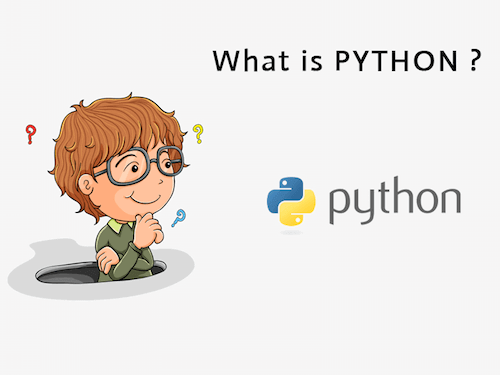
Python was made by Guido van Rossum and delivered in 1991. It is a programming language for computers of all kinds. It is an object-oriented high-level language that works equally well on Windows, Linux, UNIX, and Macintosh. its built-in high-level data structures, as well as dynamic binding and typing. It is generally utilized in information science, AI and man-made consciousness area. It requires less code to develop applications and is simple to learn. It is used extensively for:
2) Why Python?
3) What kinds of applications can Python be used for?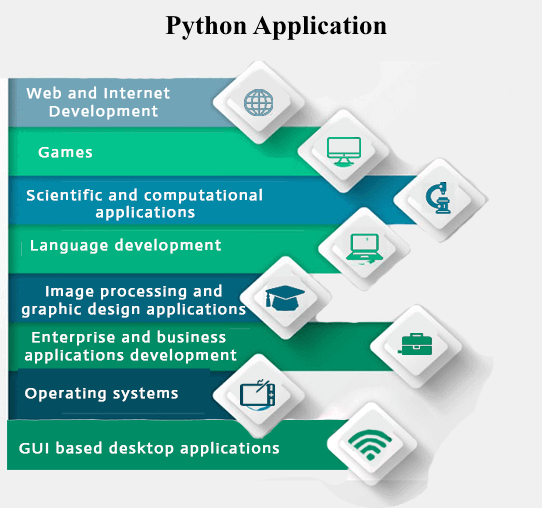
Python is utilized in several software domains, some of which are listed below.
4) What are the advantages of Python?Advantages of Python are:
Interpreted: Python is an interpreted language. It does not require prior compilation of code and executes instructions directly.
Free and open source: It is an open-source project which is publicly available to reuse. It can be downloaded free of cost.
Extensible: It is very flexible and extensible with any module.
Object-oriented: Python allows to implement the Object-Oriented concepts to build application solution.
Built-in data structure: Tuple, List, and Dictionary are useful integrated data structures provided by the language.
Portable: Python programs can run on cross platforms without affecting its performance. 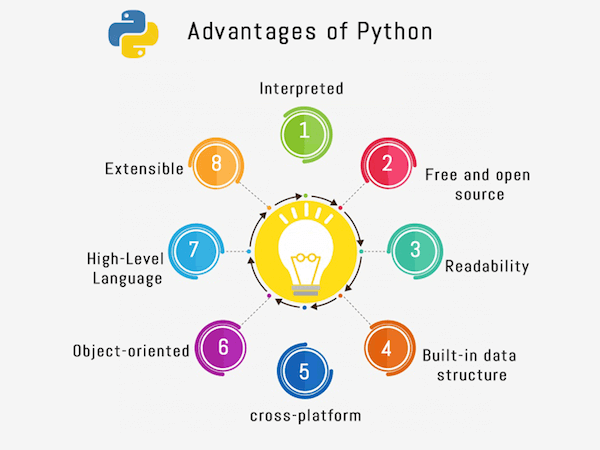
5) What is PEP 8?The Python Enhancement Proposal, also known as PEP 8, is a document that provides instructions on how to write Python code. In essence, it is a set of guidelines for formatting Python code for maximum readability. Guido van Rossum, Barry Warsaw, and Nick Coghlan wrote it in 2001. 6) What do you mean by Python literals?Literals can be defined as a data which is given in a variable or constant. Python supports the following literals: String Literals Text can be enclosed in either single or double quotes to create string literals. String literals, for instance, are values for strings. Example: Output:
JavaTpoint
JavaTpoint
Java
T
point
Numeric Literals Python supports three types of numeric literals integer, float and complex. Example: Output: 10 12.3 3.14j Boolean Literals Boolean literals are used to denote Boolean values. It contains either True or False. Example: Output: p is True q is False r: 4 s: 7 Special literals Python contains one unique exacting, or at least, 'None'. This exceptional strict is utilized for characterizing an invalid variable. In the event that 'None' is contrasted and whatever else other than a 'None', it will get back to false. Example: Output: None 7) Describe the Python Functions?A function is a piece of code that is only written once and can be executed whenever the program calls for it. A function is a self-contained block of statements with a valid name, list of parameters, and body. Capabilities make programming more practical and particular to perform measured assignments. There are a number of built-in functions for completing tasks in Python, and the user can also create new functions. Functions fall into three categories: Built-In Functions: duplicate(), len(), count() are the a few implicit capabilities. User-defined Functions: User-defined functions are functions that are defined by a user. Anonymous functions: Because they are not declared using the standard def keyword, these functions are also referred to as lambda functions. Example: A general syntax of user defined function is given below. 8) What is zip() capability in Python?The zip() function in Python returns a zip object that maps an identical index across multiple containers. It takes an iterable, transforms it into an iterator, and then uses the passed iterables to combine the elements. It returns a tuple iterator. Signature zip(iterator1, iterator2, iterator3, etc.) Parameters iterator1, iterator2, and iterator3: These are joined-together iterator objects. Return It returns a iterator that is the product of two or more iterators. Note: When the first list ends, zip stops making tuples if the given lists have different lengths. This indicates that two lists have three lengths, and a triple of five lengths will result.9) What is Python's paramter passing system?In Python, there are two mechanisms for passing parameters:
By default, all arguments (parameters) are passed to the functions "by reference." In this manner, in the event that you change the worth of the boundary inside a capability, the change is reflected in the calling capability too. It shows the first factor. For instance, if a variable is passed to a function with the declaration "a = 10" and its value is changed to "a = 20," The same value is represented by both variables. 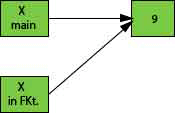
The pass by esteem is that at whatever point we pass the contentions to the capability just qualities pass to the capability, no reference passes to the capability. It makes it unchangeable, or immutable. The original value of either variable remains the same despite being modified in the function. Python has a default contention idea which assists with calling a technique utilizing an erratic number of contentions. 10) In Python, how do you overload methods or constructors?The constructor of Python: _ A class's init__ () method is the first one. Python automatically calls __init__() to initialize object members whenever we attempt to instantiate an object. In Python, we can't overload constructors or methods. If we attempt to overload, it displays an error. Example: Output: Name: rahul Email id: [email protected] 11) What is the difference between remove() function and del statement?The user can use the remove() function to delete a specific object in the list. Example: Output: [3, 5, 7, 3, 9, 3] After removal: [5, 7, 3, 9, 3] If you want to delete an object at a specific location (index) in the list, you can either use del or pop. Example: Output: [3, 5, 7, 3, 9, 3] After deleting: [3, 5, 3, 9, 3] Note: You don't need to import any extra module to use these functions for removing an element from the list.We cannot use these methods with a tuple because the tuple is different from the list. 12) What is swapcase() function in the Python?The function of a string is to change all uppercase characters into lowercase ones and vice versa. Modifying the current instance of the string is utilized. All the characters in the swap case are copied in this method's string. A small case string is produced when the string is in lowercase, and vice versa. It automatically disregards all characters that are not alphabetical. See an example below: Example: Output: it is in lowercase. IT IS IN UPPERCASE. 13) How to remove whitespaces from a string in Python?To eliminate the whitespaces and following spaces from the string, Python provides strip([str]) worked in capability. After removing any whitespaces that may be present, this function returns a copy of the string. If not, returns the original string. Example: Output:
javatpoint
javatpoint
javatpoint
After stripping all have placed in a sequence:
Javatpoint
javatpoint
javatpoint
14) How to remove leading whitespaces from a string in the Python?We can make use of the lstrip() function to get rid of leading characters from a string. It is a Python string function with an optional parameter of the char type. In the event that a boundary is given, it eliminates the person. Otherwise, it strips the string of all leading spaces. Example: Output:
javatpoint
javatpoint
After stripping all leading whitespaces:
javatpoint
javatpoint

After stripping, all the whitespaces are removed, and now the string looks like the below: 
15) Why do we use join() function in Python?The join() is defined as a string method which returns a string value. It is concatenated with the elements of an iterable. It provides a flexible way to concatenate the strings. See an example below. Example: Output: aRohanb 16) Give an example of shuffle() method?The given string or array is shuffled using this technique. The items in the array become random as a result. The random module includes this method. Therefore, we must import it before calling the function. It rearranges components each time when the capability calls and creates different result. Example: Output: Original LIST1: ['Z', 'Y', 'X', 'W', 'V', 'U'] After the first shuffle of LIST1: ['V', 'U', 'W', 'X', 'Y', 'Z'] After the second shuffle of LIST1: ['Z', 'Y', 'X', 'U', 'V', 'W'] 17) What is the use of break statement?The break statement is utilized to end the execution of the ongoing loop. Break always terminates the current execution and transfers control to a block outside of it. If the break is in a nested loop, it exits from the innermost loop. If the block is in a loop, it exits from the loop. Example: Output: 2 X 11 X 22 X 33 Y 11 Y 22 Y 33 BREAK 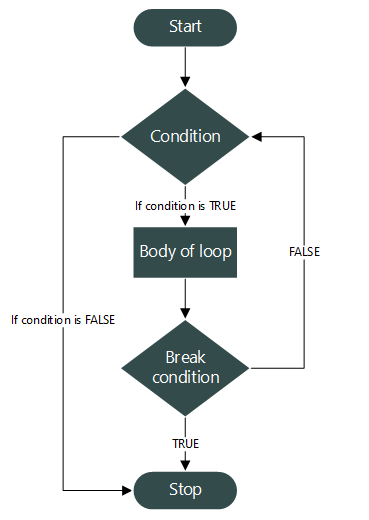
Python Break statement flowchart. 18) What is tuple in Python?A built-in type of data collection is the tuple. It permits us to store values in a grouping. Because it cannot be changed, the original data do not reflect any changes. A tuple is created with () brackets rather than [] square brackets. We are unable to remove any element, but we can locate it in the tuple. Indexing allows us to obtain elements. It likewise permits navigating components in switch request by utilizing negative ordering. There are a variety of Tuple methods, including Len(), max(), sum(), and sorted(). To create a tuple, we can declare it as below. Example: Output: (2, 4, 6, 8) 6 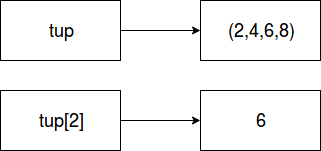
It is immutable. So updating tuple will lead to an error. Example: Output: tup[2]=22 TypeError: 'tuple' object does not support item assignment (2, 4, 6, 8) 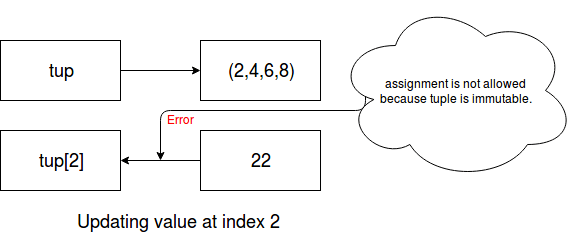
19) Which are the file related libraries/modules in Python?You can manipulate binary and text files on the file system with the help of Python's libraries and modules. It makes it easier to create, edit, copy, and delete files. The libraries are os, os.path, and shutil. Here, os and os.path - modules include a function for accessing the filesystem, while shutil - module enables you to copy and delete the files. 20) What are the different file processing modes supported by Python?There are four ways to open files in Python. The read-write (rw), write-only (w), append (a), and read-only (r) modes. 'r' is used to open a file in read-only mode; 'w' is used to open a file in write-only mode; 'rw' is used to open in both read-only and write-only modes; and 'a' is used to open a file in append mode. In the event that the mode isn't determined, of course document opens in read-just mode.
21) What is an operator in Python?An operator is a specific symbol that is applied to some values and results in an output. Operands are the work of an operator. Operands are literals or variables with numbers that have some values. Administrators can be unary, double, or ternary. A ternary operator, a binary operator, a ternary operator, and a unary operator are all examples of operators that require three or more operands, respectively. 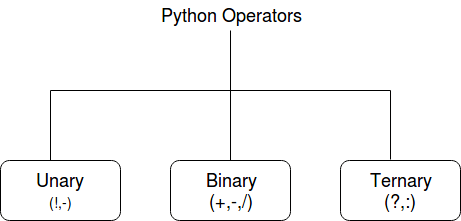
Example: Output: # Unary Operator -12 # Binary Operator 25 156 # Ternary Operator 12 22) What are the different types of operators in Python?Numerous operations can be carried out with Python's extensive set of operators. A few individual administrators like membership and identity operators are not all that recognizable yet permit to perform operations.

Arithmetic operators perform basic arithmetic operations. For example "+" is used to add and "?" is used for subtraction. Example: Output: 35 -11 276 0.5217391304347826 Relational Operators are used to comparing the values. These operators test the conditions and then returns a boolean value either True or False. # Examples of Relational Operators Example: Output: False True True True Assignment operators are used to assigning values to the variables. See the examples below. Example: Output: 12 14 12 24 576 Logical operators are used to performing logical operations like And, Or, and Not. See the example below. Example: Output: False True True Participation administrators are accustomed to checking whether a component is an individual from the grouping (list, word reference, tuples) or not. To verify an element's presence, Python employs the in and not in operators, two membership operators. See a example: Example: Output: False True Both the (is and is not) identity operators are used to check two values or variables that are in the same memory area. Two factors that are equivalent doesn't infer that they are indistinguishable. Check out the examples below. Example: Output: False True Bitwise Operators are used to performing operations over the bits. The binary operators (&, |, OR) work on bits. See the example below. Example: Output: 8 14 6 -11 23) How to create a Unicode string in Python?In Python 3, the old Unicode type has replaced by "str" type, and the string is treated as Unicode of course. Using the art.title.encode("utf-8") function, we can create a Unicode string. Example: Output:
24) is Python interpreted language?Python is a language that is interpreted. From the source code, the Python program runs directly. It turns the source code into intermediate language code, which is then again translated into machine language that needs to be run. Python does not require compilation before running, unlike Java and C. 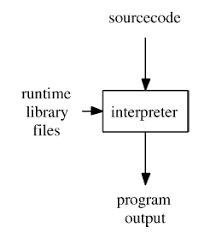
25) How is memory managed in Python?Memory is managed in Python in the following ways: Private heap space in Python handles memory management. All Python items and information structures are situated in a confidential stack. The developer doesn't approach this private load. This is handled by the Python interpreter instead. The memory manager in Python is responsible for allocating heap space to Python objects. The core API grants the programmer access to some coding tools. Additionally, Python has a built-in garbage collector that recycles all unused memory and makes it available to the heap space. 26) What is the Python decorator?Decorators are a useful Python tool that allows programmers to add functionality to existing code. They are very powerful. Because a component of the program attempts to modify another component at compile time, this is also known as metaprogramming. It permits the client to wrap one more capability to expand the way of behaving of the wrapped capability, without forever changing it. Example: Output: JavaTpoint Functions vs. Decorators A function is a block of code that performs a specific task whereas a decorator is a function that modifies other functions. 27) What are the rules for a local and global variable in Python?Global Variables: Variables declared outside a function or in global space are called global variables. We must explicitly declare a variable as "global" whenever a new value is given to it within the function because it is implicitly local. The global keyword must be used to declare a variable in order to make it global. Any function can access and alter the value of global variables, which are accessible anywhere in the program. Example: Output: JavaTpoint Local Variables: A local variable is any variable declared within a function. The local space, not the global space, contains this variable. In the event that a variable is relegated another worth anyplace inside the capability's body, being a local is expected. Only the local body can access local variables. Example: Output: JavaTpoint Local 28) What is the namespace in Python?The namespace is a fundamental concept for organizing and structuring code that is more useful in large projects. However, if you're new to programming, it might be a little hard to understand. Subsequently, we attempted to make namespaces somewhat more obvious. A namespace is characterized as a basic framework to control the names in a program. It ensures that there will be no conflict and that each name will be unique. Additionally, Python executes namespaces as word references and keeps up with name-to-protest planning where names go about as keys and the articles as values. 29) What are iterators in Python?Iterating a collection of elements, similar to a list, in Python is accomplished with iterators. Iterators can be lists, tuples, or dictionaries-the collection of items. To iterate over the stored elements, Python iterator uses the __itr__ and next() methods. In Python, we for the most part use circles to emphasize over the assortments (list, tuple). Simply stated: Iterators are objects which can be crossed however or iterated upon. 30) What is a generator in Python?In Python, the generator is a way that determines how to execute iterators. Except for the fact that it produces expression in the function, it is a normal function. It eliminates the __itr__ and next() methods and reduces additional overheads. On the off chance that a capability contains essentially a yield explanation, it turns into a generator. By saving its states, the yield keyword pauses the current execution and allows it to be resumed whenever necessary. 31) What is slicing in Python?Slicing is a system used to choose a scope of things from succession type like rundown, tuple, and string. Getting components from a reach by utilizing slice way is valuable and simple. It requires a : ( colon) what isolates the beginning and end record of the field. Slicing is supported by all data collection types, including List and tuples. Using slicing, we can get a group of elements, whereas by specifying an index, we can only get one element. 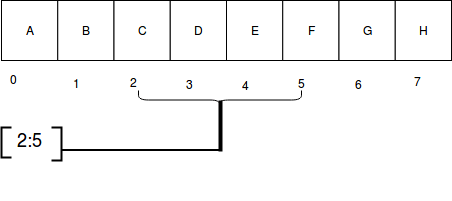
Example: Output: vaTpoint, Python Interv 32) What is a dictionary in Python?A built-in data type is the Python dictionary. A one-to-one relationship between keys and values is established by this. A pair of keys and their values are contained in dictionaries. It stores components in key and worth matches. Values can be duplicated, whereas keys are unique. The dictionary elements are accessed by the key. Keys index dictionaries. Example: The following example contains some keys Country Hero & Cartoon. Their corresponding values are India, Modi, and Rahul respectively. Output: Country: India Hero: Modi Cartoon: Rahul 33) What is Pass in Python?Pass specifies an operation-free Python statement. It is in a compound statement as a placeholder. To make a vacant class or works, the pass catchphrase assists with passing the control without error. Example: 34) Explain docstring in Python?The first statement in a module, function, class, or method definition is the Python docstring, a string literal. It makes it easier to link the documents together. "Attribute docstrings" are string literals that occur immediately after a straightforward assignment at the top. "Additional docstrings" are string literals that occur immediately after another docstring. Despite fitting on a single line, docstrings are created by Python using triple quotes. The phrase in docstring ends with a period (.) and may include several lines. It may include special characters like spaces. Example: 35) What is a negative index in Python and why are they used?Python's sequences are indexed and contain both positive and negative numbers. The numbers that are positive purposes '0' that is utilizes as first record and '1' as the subsequent file and the cycle go on that way. The negative number's index begins with '-1,' which denotes the sequence's final index, and ends with '-2,' which denotes the sequence's penultimate index. The negative index is used to get rid of any new-line spaces in a string and make it possible for the string to contain all but the last character, S[:-1]. The negative index is also used to show the correct order in which the index represents the string. 36) What is pickling and unpickling in Python?A module known as the Python pickle is one that transforms any Python object into a string representation. Utilizing the dump function, it copies the Python object to a file; this cycle is called Pickling. Unpickling is the procedure of obtaining the original Python objects from the stored string representation. 37) Which programming language is a good choice between Java and Python?Java and Python both are object-oriented programming languages. Let's compare both on some criteria given below:
38) What is the usage of help() and dir() function in Python?Help() and dir() the two capabilities are open from the Python mediator and utilized for review a united dump of implicit capabilities. Function "help()": The help() function enables us to view module, keyword, and attribute-related help in addition to displaying the documentation string. The Dir() method: The defined symbols are displayed using the dir() function. 39) What are the differences between Python 2.x and Python 3.x?Python 2.x is a previous version. Python 3.x is the most recent release. Python 2.x is inheritance now. This language is both now and in the future Python 3.x. The most noticeable contrast somewhere in the range of Python2 and Python3 is on paper explanation (capability). It looks like print "Hello" in Python 2, and it looks like print ("Hello") in Python 3. String in Python2 is ASCII verifiably, and in Python3 it is Unicode. The xrange() technique has eliminated from Python 3 variant. Error handling introduces a brand-new keyword. 40) How Python does Compile-time and Run-time code checking?The majority of the checking for things like type, name, and so on is done at compile time in Python. are deferred until code execution. As a result, the Python code will compile successfully if it refers to a user-defined function that does not exist. With one exception, the Python code will fail when the execution path is missing. 41) What is the shortest method to open a text file and display its content?The shortest way to open a text file is by using "with" command in the following manner: Example: Output: "The data of the file will be printed." 42) What is the usage of enumerate () function in Python?The enumerate() function is used to iterate through the sequence and retrieve the index position and its corresponding value at the same time. Example: Output: Return type: 43) Give the output of this example: A[3] if A=[1,4,6,7,9,66,4,94].Since indexing starts from zero, an element present at 3rd index is 7. So, the output is 7. 44) What is type conversion in Python?Type conversion refers to the conversion of one data type iinto another. int() - converts any data type into integer type float() - converts any data type into float type ord() - converts characters into integer hex() - converts integers to hexadecimal oct() - converts integer to octal tuple() - This function is used to convert to a tuple. set() - This function returns the type after converting to set. list() - This function is used to convert any data type to a list type. dict() - This function is used to convert a tuple of order (key,value) into a dictionary. str() - Used to convert integer into a string. complex(real,imag) - This functionconverts real numbers to complex(real,imag) number. 45) How to send an email in Python Language?Python has the smtplib and email modules for sending emails. Import these modules into the made mail script and send letters by confirming a client. It has a strategy SMTP(smtp-server, port). It requires two boundaries to lay out SMTP connection. A simple example to send an email is given below. Example: 46) What is the difference between Python Arrays and lists?In Python, lists and arrays both store data in the same way. However, lists can hold any data type of elements, whereas arrays can only hold one data type of elements. Example: Output:
array('i', [1, 2, 3, 4])
[1, 'abc', 1.2]
47) What is lambda function in Python?The anonymous capability in python is a capability that is characterized without a name. The ordinary capabilities are characterized utilizing a catchphrase "def", though, the mysterious capabilities are characterized utilizing the lambda capability. Lambda functions are another name for anonymous functions 48) Why do lambda forms in Python not have the statements?Since the statement is used to create the new function object and return it at runtime, lambda forms in Python do not include it. 49) What are functions in Python?A function is a piece of code that only runs when called. The def keyword is utilized when defining a Python function. Example: Output: Hi, Welcome to JavaTpoint 50) What is __init__?The __init__ is a method or constructor in Python. This method is automatically called to allocate memory when a new object/ instance of a class is created. All classes have the __init__ method. Example: Output: pqr 20 25000 51) What is self in Python?Self is a class's instance or object. This is explicitly set as the first parameter in Python. Be that as it may, this isn't true in Java where it's discretionary. It assists with separating between the techniques and properties of a class with neighborhood factors. The newly created object is referred to as the self-variable in the init method, whereas the object whose method was called is referred to in other methods. 52) In Python, how can you generate random numbers?Irregular module is the standard module that is utilized to create an irregular number. The term "method" refers to: The statement random.random() strategy return the drifting point number that is in the scope of [0, 1). Float numbers are generated at random by the function. The bound methods of the hidden instances are the ones that are utilized with the random class. The Random instances can be used to demonstrate multi-threading applications that generate distinct thread instances. The following are additional random generators utilized in this: range (a, b): it picks a number and characterize the in the middle between [a, b). It returns the components by choosing it arbitrarily from the reach that is determined. It does not create an object of range. uniform, a and b: It selects a floating-point number from the [a,b] range and returns the following floating-point number: normalvariate(mean, sdev) It is utilized in the normal distribution, where the mu represents the mean and the sdev represents the standard deviation. Multiple independent random number generators are created by the Random class, which is used and instantiated. 53) What is PYTHONPATH?PYTHONPATH is a enviroment variable which is utilized when a module is imported. PYTHONPATH is also looked up whenever a module is imported to see if the imported modules are in different directories. It is used by the interpreter to choose which module to load. 54) What are modules in Python? Name a few regularly utilized worked in modules in Python?Modules in Python are files that contain Python code. This code can either be capabilities classes or factors. A Python module is a.py file with code that can be run. Some of the commonly used built-in modules are:
55) What is the difference between range & xrange?In most respects, the functionality of xrange and range is identical. You can use them both to generate a list of integers in any way you like. The main distinction is that reach returns a Python list item and x reach returns a xrange object. This indicates that unlike range, xrange does not actually produce a static list at runtime. It makes the qualities as you want them with a unique strategy called yielding. Generators are a type of object that can benefit from this approach. This indicates that the function to use is xrange if you want to create a list for a really large range, such as one billion. This is especially true when working with a memory-sensitive system like a mobile phone because range will use as much memory as it can to create your integer array, which could cause a Memory Error and cause your program to crash. It's a beast that needs memories. 56) What benefits do NumPy exhibits offer over (nested) Python records?Lists in Python work well as general-purpose containers. Due to Python's list comprehensions, they are simple to construct and manipulate, and they support insertion, deletion, appending, and concatenation in a fairly efficient manner. They are constrained in a few ways: Because they can contain objects of different types, Python must store type information for each element and execute type dispatching code when operating on each element because they do not support "vectorized" operations like addition and multiplication by elements. Not only is NumPy more effective, it is additionally more helpful. Numerous free vector and matrix operations enable us to sometimes avoid unnecessary work. Additionally, they are effectively implemented. NumPy cluster is quicker and we get a ton worked in with NumPy, FFTs, convolutions, quick looking, essential measurements, straight polynomial math, histograms, and so on. 57) Mention what the Django templates consist of.A simple text file serves as the template. Any text-based format, including XML, CSV, and HTML, can be created by it. A layout contains factors that get supplanted with values when the format is assessed and labels (% tag %) that control the rationale of the layout. 
58) Explain the use of session in Django framework?Django gives a meeting that allows the client to store and recover information on a for each site-guest premise. By placing a session ID cookie on the client side and storing all relevant data on the server side, Django abstracts the sending and receiving of cookies. 
So, the data itself is not stored client side. This is good from a security perspective. Interview based Multiple Choice Questions on Python1) Which of the accompanying Statements is/are Valid in regard of the Python programming language? Statement 1: Python is a high-level, general-purpose, interpreted programming language. Statement 2: For rapid application development and deployment, Python offers dynamic binding and typing in addition to high-level data structures. Statement 3: Python is a programming language with statically typed code. Options:
Answer: B: Statement 1 and 2 Explanation: Python is a high-level, general-purpose, interpreted programming language. Being a deciphered language, it executes each block of code line by line, and consequently type-checking is finished while executing the code. As a result, it is a language with dynamic typing. Besides, Python offers undeniable level information structures, along with dynamic restricting and composing, permits a large community of engineers for Quick Application Improvement and Organization. 2) What is the full form of PEP? Options:
Answer: A: Python Enhancement Proposal Explanation: A PEP, otherwise called Python Improvement Proposition, is an authority configuration report offering data to the local area of Python engineers or portraying another element for Python or its techniques. 3) Which of the accompanying Statements is/are NOT right in regard to Memory The executives in Python? First Statement: Python's memory management is handled by Python Memory Manager. 2nd Statement: As the garbage collection method for Python, the CMS (Concurrent Mark Sweep) approach is utilized. Statement 3: In order to recycle the free memory for the private heap space, Python provides a core garbage collection feature. Options:
Answer: D: Only Statement 2 Explanation: Python utilizes the Reference Considering calculation its Garbage Assortment method. This method is easy to use and very effective; It cannot, however, identify the reference cycle. As a result, the reference cycle is the sole focus of Python's Generational Cyclic (GC) algorithm. 4) Which of the following statements about Python namespaces is true or false? First statement: Python carries out the namespace as Exhibit. 2nd Statement: There are three types of Python namespaces: local, global, and built-in. Statement 3: A Python namespace guarantees that each object's name is unique and can be used without being inconsistent. Options:
Answer: A: Only Statement 1 Explanation: The namespaces in Python are carried out as Word references where 'key' signifies the 'name', planned to a comparing 'esteem' signifying the 'object'. 5) Which of the following is invalid in terms of Variable Names? Options:
Answer: D: None of the mentioned Explanation: The execution of each statement will be successful. Be that as it may, the code readability will likewise be decreased. 6) In respect to the scope in Python, which of the following statements is/are TRUE? Statement 1: A variable created within a function belongs to the local scope and can be used outside that function. Statement 2: A local scope is referred to the object present through the execution of code since its inception. Statement 3: A local scope is referred to the local object present in the current function. Options:
Answer: C: Only Statement 3 Explanation: Local scope, otherwise called capability scope, is the block of code or body of any capability in Python. The names that we specify within the function make up this scope. Only the function code will be able to see these names. We will have as many distinct local scopes as calls to the function because it is created at the function call rather than at the function's definition. This holds true regardless of whether the same function is called multiple times or recursively. Each call will return another nearby extension. 7) What will the following snippet of code print? Code: Options:
Answer: A: 10 Explanation: 10 is printed. Whenever we redistribute a worldwide variable in the local extent of a capability, the movement just holds inside the nearby extension. When the code returns the global scope, the variable returns to the global value. 8) What will the following snippet of code yield? Code: Options:
Answer: C: 21 Explanation: 21 is printed. In the beginning, 21 is assigned to the variable myint. Since the if False statement predicts False, the myint = 34 reassignment never takes place. The reassignment that takes place in the myfunction() function takes place not in the global scope but rather in the local scope. The value of the variable myint in the global scope remains unchanged at 21 when we attempt to access it. 9) Among the following statements based on the difference between lists and tuples, which one statement is TRUE? Statement 1: List is a sequence data structure, whereas Tuple is not. Statement 2: Lists are immutable; however, Tuples are mutable. Statement 3: Tuple is a sequence data structure, whereas List is not. Statement 4: Tuples are immutable; however, Lists are mutable. Options:
Answer: B: Statement 4 Explanation: Aside from numerous similitudes, one of the massive contrasts between the two is that the Rundowns are changeable, though Tuples are unchanging. This assertion suggests that we can change or change the upsides of a rundown; be that as it may, we can't change the upsides of a Tuple. 10) What will be the output of the following snippet of code? Code: Options:
Answer: A: [7, 9, 2, 5, 0, 1, 3, 6] Explanation: The element is removed from the list using the pop() function. The data element to be removed from the list's index value, n, is the function's parameter. Subsequently, the pop(n) capability eliminates the nth component from the rundown. The index number is 2, just like in the case above. As a result, the pop(2) function removes element 8 from my_list. |
You may also like:
- Java Interview Questions
- SQL Interview Questions
- Python Interview Questions
- JavaScript Interview Questions
- Angular Interview Questions
- Selenium Interview Questions
- Spring Boot Interview Questions
- HR Interview Questions
- C Programming Interview Questions
- C++ Interview Questions
- Data Structure Interview Questions
- DBMS Interview Questions
- HTML Interview Questions
- IAS Interview Questions
- Manual Testing Interview Questions
- OOPs Interview Questions
- .Net Interview Questions
- C# Interview Questions
- ReactJS Interview Questions
- Networking Interview Questions
- PHP Interview Questions
- CSS Interview Questions
- Node.js Interview Questions
- Spring Interview Questions
- Hibernate Interview Questions
- AWS Interview Questions
- Accounting Interview Questions







